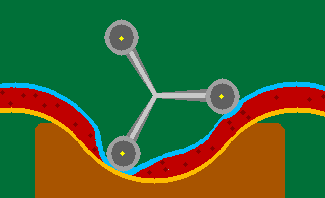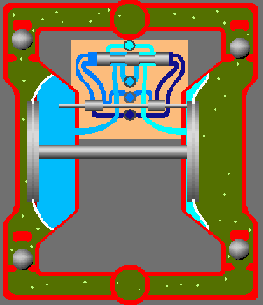Animated Pumps
| Piston Pump
|
Piston pumps can be motor or solenoid driven. It moves a piston, generally connected to a diaphragm, back and forth to generate flow. The pump will generate the pressure required to move the "unit" of fluid along. It uses ball checks and seat seals in order to work. It is commonly used in metering applications for precise, repeatable addition of chemical additives. Resulting flow is normally pulsating in nature. |
|
Peristaltic Pump |
Flow occurs as a result of squeezing the hose of tube from the outside by means of a sliding shoe or roller. There are no check valves, seats, shaft seals, or any moving parts in contact with the fluid being pumped. The hose or tube is the major wearing part. It is unaffected by the abrasive nature of the fluid, thus is commonly used to handle very abrasive slurries. It has excellent repeatable performance and is many times used to meter slurries to processes. Resulting flow will be pulsating and not smooth. |
|
Gear Pump |
Pumping action results from two (2) opposing gears turning together to open and close internal areas between the gear teeth. There are areas inside these pumps where the liquid can find its way from the high pressure (discharge) side back to the low pressure (suction) side. This "slip" is attributable to the internal tolerances between the gears, wear plates, bearings, housing walls, etc. Changes in the fluid viscosity, suction pressure, discharge pressure, temperature can change the flow rate, because they affect the "internal slip rates". Flow is generally smooth and pulse free. |
|
Double Diaphragm Pump |
Normally powered by compressed air, they have two diaphragms operating on a single shaft. They are set 180 degrees out of phase. Thus, when one side is in the suction cycle, the other side is in the discharge cycle. They use check valves in suction and discharge. Can handle liquids with high solids content, low and high viscosity fluids. Generally good suction lift characteristics. Discharge pressures are limited to compressed air pressure or about 100 PSIG. Best suited for transfer or filling applications, but can be controlled for some metering applications. Flow is very pulsing. |





